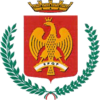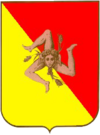Palermo
| Comune di Palermo | |||
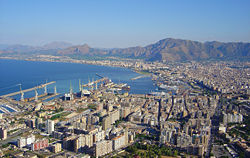 |
|||
|
|||
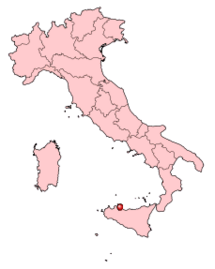 |
|||
| Coordinates: | |||
| Region | Sicily | ||
|---|---|---|---|
| Province | Province of Palermo | ||
| Founded | 734 BC | ||
| Government | |||
| - Mayor | Diego Cammarata | ||
| Area | |||
| - City | 158 km² (61 sq mi) | ||
| Population (January 2006) | |||
| - City | 785,018 (5th) | ||
| - Density | 4,275/km² (11,072.2/sq mi) | ||
| - Metro | 1,315,870 | ||
| Time zone | CET (UTC+1) | ||
| - Summer (DST) | CEST (UTC+2) | ||
| Postal codes | 90100 | ||
| Area code(s) | 091 | ||
| Patron saints | Saint Rosalia | ||
| Website: http://www.comune.palermo.it | |||
Palermo (Sicilian: Palermu, Greek: Panormus) is a historic city in southern Italy, the capital of the autonomous region Sicily and the province of Palermo. The city is noted for its rich history, culture, architecture and gastronomy, playing an important role throughout much of its existence; it is over 2,700 years old. Palermo is located in the north-west of the island of Sicily, right by the Gulf of Palermo in the Tyrrhenian Sea.
The city was founded by the Phoenicians, but named by the Ancient Greeks as Panormus meaning all port. Palermo became part of the Roman Republic and eventually part of the Byzantine Empire, for over a thousand years. For a brief period it was under Arab rule where it first became a capital. Following the Norman reconquest, Palermo would become capital of a new kingdom from 1130 to 1816 the Kingdom of Sicily. Eventually it would be united with the Kingdom of Naples to form the Two Sicilies until the Italian unification of 1860.
The metropolitan area of Palermo is the fifth most populated in Italy and in the top eighty of the largest in all of Europe with around 1.2 million people. In the central area, the city itself has a population of around 670 thousand people, the inhabitants are known as Palermitans or poetically panormiti, the language spoken by its inhabitants is the Sicilian language.
The religion of Roman Catholicism is highly important in Palermitan culture, the patron saint of the city is Saint Rosalia, her feast day on July 15 is perhaps the biggest social event in the city. The area attracts significant amounts of tourists each year and is widely known for its colourful fruit, vegetable and fish market at the heart of Palermo known as the Vucciria.[1]
Contents |
History
Antiquity
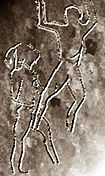
Evidence for human settlement in the area now known as Palermo goes back to the Pleistocene Epoch, around 8000 BC.[2] This evidence is present in the form of cave drawings at nearby Addaura crafted by the Sicani, who according to Thucydides arrived from the Iberian Peninsula (perhaps Catalonia).[3][4] During 734 BC the Phoenicians, a sea trading peoples from the north of ancient Canaan built a small settlement on the natural habour of Palermo, some sources suggest they named the settlement Zîz.[5] The Greeks who were the most dominant culture on the island of Sicily, due to the powerful city state of Syracuse to the east, instead called the settlement Panormus. Its Greek name means "all-port" and it was named as so because of its fine natural harbour.[5] Palermo was then passed on to the Phoenician's descendants and successors, in the form of the Carthaginians.[6]
During this period it was a centre of commerce; however a power struggle between the Greeks and the Carthaginians broke out in the form of the Sicilian Wars, causing unrest. It was from Palermo that Hamilcar's fleet which was defeated at the Battle of Himera was launched.[6] Palermo eventually became a Greek colony when Pyrrhus of Epirus gained it during the Pyrrhic War period in 276 BC.[7] However as the Romans flooded into Sicily during the First Punic War, the city became under Roman rule only three decades later. The Romans made sure that, in the words of Roman consul M. Valerian to the Roman Senate; "no Carthaginian remains in Sicily".[8] This period was quite a calm time for Palermo, which was growing into an important Roman trade centre, also during this period Christianity first began to be practiced in Palermo.[7][9]
The Middle Ages
As the Roman Empire was falling apart, Palermo fell under the control of several Germanic tribes; first were the Vandals in 440 AD under the rule of their king Geiseric. The Vandals had already invaded other parts of western Europe establishing themselves as a significant force.[10] However, they soon lost these newly acquired possessions to another East Germanic tribe in the form of the Goths.[10] The Ostrogothic conquest under Theodoric the Great began in 488; although the Goths were Germanic, Theodoric sought to revive Roman culture and government instead.[11] The Gothic War took place between the Ostrogoths and the Eastern Roman Empire, also known as the Byzantine Empire. Sicily was the first part of Italy to be taken under general Belisarius who was commissioned by Eastern Emperor Justinian I who solidified his rule in the following years.[12][13]

After the Byzantines were betrayed by admiral Euphemius, who fled to Tunisia and begged the Aghlabid leader Ziyadat Allah to help him there was a Muslim conquest of Sicily, putting in place the Emirate of Sicily.[14] The Arab rulers allowed the natives freedom of religion on the condition that they paid a tax. Although their rule was short in time, it was then that Palermo displaced Syracuse as the prime city of Sicily; it was said to have competed with Córdoba and Cairo in terms of importance and splendor.[15] The Arabs also introduced many agricultural items which remain a mainstay of Sicilian cuisine.[10] After dynasty related quarrels however, there was a Christian reconquest in the form of the Normans from the Duchy of Normandy, descendants of the Vikings; the family who returned the city to Christianity were called the Hautevilles .[14] Palermo was back under Christian rule by 1072 due largely to the efforts of Robert Guiscard and his army, who is regarded as a hero by the natives.[16]

It was under Roger II of Sicily that his holdings of Sicily and the southern part of the Italian Peninsula were promoted, from the County of Sicily into the Kingdom of Sicily; the kingdom was ruled from Palermo as its capital, with the king's court held at Palazzo dei Normanni. Much construction was undertaken during this period, such as the building of the Palermo Cathedral. The Kingdom of Sicily became one of the wealthiest states in Europe, as wealthy as fellow Norman state the Kingdom of England.[17] Sicily in 1194 fell under the control of the Holy Roman Empire. Palermo was the preferred city of the Emperor Frederick II. Muslims of Palermo were migrated and expelled during Holy Roman rule. After an interval of Angevin rule (1266-1282), Sicily came under the house of Aragon and later, in (1479), the kingdom of Spain until 1713 and between 1717–1718. Palerrmo also managed by Savoy between 1713–1717 and 1718-1720 and Austria between 1720-1734.
Two Sicilies and Italian unification
Sicily's unification (1734) with the Bourbon-ruled kingdom of Naples as the kingdom of the Two Sicilies inflicted a devastating blow on the elite of Palermo, as the city was reduced to just another provincial city, the royal court residing in Naples. Palermo rebelled in 1848 and held out against the Neapolitan crown until May 1849.
The Italian Risorgimento and Sicily's annexation (1860) to the kingdom of Italy gave Palermo a second chance. It was once again the administrative centre of Sicily, and there was a certain economic and industrial development. In the second half of the 19th century Palermo expanded beyond the historical centre, especially towards Via della Libertá. Monumental public buildings were erected and a new thoroughfare was cut into the dense old town, called Via Roma. The city was one of the main centres of Art Nouveau style in Italy.
Palermo survived almost the entire fascist period unscathed, but during the Allied invasion of Sicily in July 1943 it suffered heavy damage.
The importance of Palermo got another boost when Sicily became (1947) an autonomous region with extended self-rule. But any improvement was thwarted by the rising power of the Mafia, which still today is a dramatic feature of the city, as well as the whole Southern Italy.
Main sights
Palermo has a noteworthy architectural heritage and is notable for its many Norman buildings.
Churches
- The Cathedral of Palermo (1185).
- San Giovanni dei Lebbrosi (1071)
- San Giovanni degli Eremiti (1132)
- Martorana (Santa Maria dell'Ammiragliato, 1143)
- San Cataldo (12th century)
- Santa Maria della Gancia
- Santa Maria della Catena
- San Giuseppe dei Teatini
- Oratorio di San Lorenzo
- Oratorio del Rosario
- Santa Teresa alla Kalsa derives its name from Al-Khalisa, an arab term meaning elected. The church, constructed in 1686–1706 over the former emir's residence, is one of the most outstanding examples of Sicilian Baroque. It has a single, airy nave, with stucco decorations from the early 18th century.
- Santa Maria dello Spasimo was built in 1506 and later turned into a hospital. For this temple Raphael painted his famous Sicilia's Spasimo, now in the Museo del Prado of Madrid. The church today is a fascinating air-open ruin, which occasionally houses exhibitions and musical shows.
- the Church of the Jesus (Chiesa del Gesù) was built by the Jesuits in the centre of the city from 1564, over a pre-existing convent of Basilian monks. The edifice was further enlarged starting from 1591, becoming one of the most relevant examples of Sicilian Baroque, though retaining some severe late Renaissance fashion. The church was heavily damaged after the 1943 bombings, which destroyed most of the frescoes. The interior has a Latin cross plan with a nave and two aisles, characterized by a particularly rich decoration of marbles, tarsias and stuccoes, especially in the St. Anne chapel. At the right is the Casa Professa, with a 1685 portal and a precious 18th century cloister. The Church of the Jesus is home to the Municipal Library, placede here in 1775.
- The church of St. Francis of Assisi, erected in what was once the market district of the city. It was built between 1255 and 1277 in the site of two pre-existing churches, and was largely renovated in the 15th, 16th, 18th and 19th centuries, the latter after an earthquake. After the 1943 bombings, the church was restored to its Mediaeval appearance, which now includes part of the original building such as part of the right side, the apses and the Gothic portal in the façade. The interior has a typical Gothic flavour, with a nave and two aisles separated by two rows of cylindrical pilasters. Some of the chapels are in Renaissance style, as well as the late 16th century side portals. The church includes precious sculptures by Antonio and Giacomo Gagini, and Francesco Laurana, plus a noteworthy wooden choir dating from the 16th century. Of note are also the allegorical statues by Giacomo Serpotta (1723), also author of the stucco decoration.
- The church of the Magione (officially church of the Holy Trinity), an ancient example of Norman architecture. The church was founded in 1191 by Matteo d'Ajello, who donated it to the Cistercian monks.
Palaces and museums
- Palazzo dei Normanni, one of the most beautiful Italian palaces and a notable example of Norman architecture, probably built over an Arab fortress. It houses the famous Cappella Palatina.
- Zisa (1160) and Cuba, magnificent castles/houses used by the kings of Palermo for hunting. Similar buildings were common in northern Africa, but today these two are the only ones remaining. The Zisa houses the Islamic museum. The Cuba was once encircled by water.
- Palazzo Chiaramonte
- Palazzo Abatellis, with the Regional Gallery. It was built at the end of the 15th century for the prefect of the city, Francesco Abatellis. It is a lassive though elegant construction, in typical Catalan Gothic style, with Renaissance influences. The Gallery houses an Elenora of Aragon bust by Francesco Laurana (1471) and the Malvagna Triptych (c. 1510), by Jan Gossaert and the famous Annunziata by Antonello da Messina. The exposition in the museum has been designed by the famous architect Carlo Scarpa.
- The Museo Archeologico Regionale is one the main museums of Italy: it includes numerous remains from Etruscan, Carthaginian, Roman and Hellenistic civilizations. It houses all the decorative parts from the Sicilian temples of Segesta and Selinunte.
Opera Houses
- The Teatro Massimo ("Greatest Theatre") was opened in 1897. Closed for renovation from 1974 until 1997, it is now carefully restored and has an active schedule. Enrico Caruso sang in a performance of La Gioconda during the opening season, returning for Rigoletto at the very end of his career. It is the largest theater in Italy (8000 sm).
- The Teatro Politeama was built between 1867 and 1874. Nowadays, the town's Gallery of Modern Art is accommodated here.
Squares
- Quattro Canti is a small square at the crossing of the ancient main roads (now: Corso Vittorio Emanuele and Via Maqueda) dividing the town into its quarters ('mandamenti'). The buildings at the corner have diagonal baroque facades so that the square gets an almost octagonal form.
- Piazza Pretoria was planned in the 16th century near the Quattro Canti as the site of a fountain by Francesco Camilliani, the Fontana Pretoria.
Other sights
The Cathedral has a heliometer (solar "observatory") of 1690, one of a number[18] built in Italy in the 17th and 18th centuries. The device itself is quite simple: a tiny hole in one of the minor domes acts as Pinhole camera, projecting an image of the sun onto the floor at solar noon (12:00 in winter, 13:00 in summer). There is a bronze line, la Meridiana on the floor, running precisely N/S. The ends of the line mark the positions as at the summer and winter solstices; signs of the zodiac show the various other dates throughout the year.
The purpose of the instrument was to standardise the measurement of time and the calendar. The convention in Sicily had been that the (24 hour) day was measured from the moment of sun-rise, which of course meant that no two locations had the same time and, more importantly, did not have the same time as in St. Peter's Basilica in Rome. It was also important to know when the Vernal Equinox occurred, to provide the correct date for Easter.
The Orto botanico di Palermo, founded in 1785, is the largest in Italy with a surface of 10 ha.
One site of interest is the Capuchin Catacombs, with many mummified corpses in varying degrees of preservation.
Close to the city is 600-metre (1,970 ft) high Monte Pellegrino, with spectacular views of the city, its surrounding mountains and the ocean. .
Demographics
In 2007, there were 666,552 people residing in Palermo (in which 1 million live in the greater Palermo area), of whom 47.6% were male and 52.4% were female. Minors (children ages 18 and younger) totalled 21.64 percent of the population compared to pensioners who number 16.54 percent. This compares with the Italian average of 18.06 percent (minors) and 19.94 percent (pensioners). The average age of Palermo resident is 37 compared to the Italian average of 42. In the five years between 2002 and 2007, the population of Palermo declined by 2.92 percent, while Italy as a whole grew by 3.56 percent. The reason for Palermo's decline is a population flight to the suburbs, and Northern Italy.[1][2] The current birth rate of Palermo is 10.75 births per 1,000 inhabitants compared to the Italian average of 9.45 births.
As of 2006, 97.79% of the population was of Sicilian/Italian descent. The largest immigrant group came from South Asia (mostly from Sri Lanka): 0.80%, other European countries (mostly from Serbia and Poland): 0.3%, and North Africa (mostly from Tunisia): 0.28%.[19]
Sports
Palermo has its own football team, U.S. Città di Palermo, playing in Italian Serie A and in UEFA Cup first round of the 2007–2008 season. The chairman is Maurizio Zamparini and the coach is Davide Ballardini. The Targa Florio was an open road endurance car race held near Palermo. Founded in 1906, it used to be one of the oldest sports car racing events until it was discontinued in 1977 due to safety concerns but has since run as a rallying event.
Palermo was home to the grand depart of the 2008 Giro d'Italia. The initial stage was a 28.5 km long TTT (Team Time Trial) held on May 10.
Internazionali Femminili di Palermo is a WTA Tour Tier IV tournament in Palermo.
Patron saints
The patron saint of Palermo is Santa Rosalia, who is still widely venerated. On 14 July, people in Palermo celebrate the Festino, the most important religious event of the year. The Festino is a procession in the main street of Palermo to remember the miracle attributed to Santa Rosalia who, it is believed, freed the city from the Black Death in 1624. The cave where the bones of Santa Rosalia were discovered is on Monte Pellegrino (see above): when her relics were carried around the city three times, the plague was lifted. There is a Santuario marking the spot and can be reached via a scenic bus ride from the city below.
Before 1624 Palermo had four patron saints, one for each of the four major parts of the city. They were Saint Agatha, Saint Christina, Saint Ninfa and Saint Olivia.
Saint Lucy is also honoured with a peculiar celebration, during which inhabitants of Palermo do not eat anything made with flour, but boil wheat in its natural state and use it to prepare a special dish called cuccìa. This commemorates the saving of the city from famine through the intercession of St Lucia. A ship full of grain mysteriously arrived in the city's harbour and the population was so hungry that they did not waste time in making flour but ate the grain as it had arrived.
Geography
Quarters
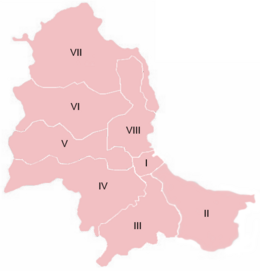
| Municipality | Quarters |
|---|---|
| I | Kalsa, Albergheria, Seralcadio & La Loggia |
| II | Settecannoli, Brancaccio & Ciaculli-Oreto |
| III | Villagrazia-Falsomiele & Stazione-Oreto |
| IV | Montegrappa, S. Rosalia, Cuba, Calafatimi, Mezzomonreale, Villa Tasca-Altarello & Boccadifalco |
| V | Zisa, Noce, Uditore-Passo di Rigano & Borgo Nuovo |
| VI | Cruillas, S. Giovanni Apostolo, Resuttana & San Lorenzo |
| VII | Pallavicino, Tommaso Natale, Sferracavallo, Partanna Mondello, Arenella, Vergine Maria & San Filippo Neri |
| VIII | Politeama, Malaspina-Palagonia, Libertà & Monte Pellegrino |
Shown above are the thirty five quarters of Palermo: these thirty five neighbourhoods or "quartiere" as they are known, are further divided into eight governmental community boards.[20]
Climate
| Month | Jan | Feb | Mar | Apr | May | Jun | Jul | Aug | Sep | Oct | Nov | Dec | Year |
|---|---|---|---|---|---|---|---|---|---|---|---|---|---|
| Average high °F (°C) | 59 (15) |
59 (15) |
61 (16) |
65 (18) |
71 (22) |
77 (25) |
82 (28) |
83 (28) |
79 (26) |
73 (23) |
66 (19) |
60 (16) |
70 (21) |
| Average low °F (°C) | 50 (10) |
50 (10) |
51 (11) |
55 (13) |
60 (16) |
67 (19) |
73 (23) |
74 (23) |
70 (21) |
64 (18) |
57 (14) |
52 (11) |
61 (16) |
| Precipitation inches (mm) | 2.8 (71.1) |
2.6 (66) |
2.3 (58.4) |
1.7 (43.2) |
1 (25.4) |
0.5 (12.7) |
0.2 (5.1) |
0.5 (12.7) |
1.6 (40.6) |
3.9 (99.1) |
3.7 (94) |
3.2 (81.3) |
24.1 (612.1) |
| Source: Weatherbase[21] 19 February 2008 | |||||||||||||
Palermo enjoys a typical Mediterranean climate with mild, wet winters and warm to hot, dry summers.
Transport
Palermo International Airport, also known as Falcone-Borsellino Airport, Punta Raisi Airport: dedicated to Giovanni Falcone and Paolo Borsellino, two anti-mafia judges killed by the mafia in early 1990s, is located 32 km (19 miles) west of Palermo (Punta Raisi).
The airport can also be reached by trains departing from Centrale, Notarbartolo and Francia stations.
Twin cities
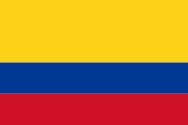 Palermo, Colombia
Palermo, Colombia Bizerte, Tunisia
Bizerte, Tunisia Bukavu, Zaire
Bukavu, Zaire Chengdu, China
Chengdu, China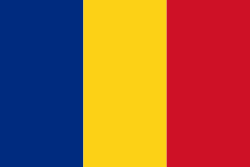 Timişoara, Romania
Timişoara, Romania Gdańsk, Poland
Gdańsk, Poland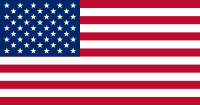 Miami, USA
Miami, USA Monterey, Canada
Monterey, Canada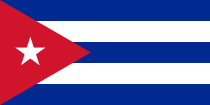 Santiago de Cuba, Cuba
Santiago de Cuba, Cuba Tblisi, Georgia
Tblisi, Georgia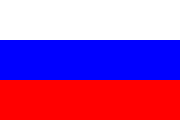 Yaroslavl, Russia
Yaroslavl, Russia
References
Sources
- ↑ "In Palermo, Life Vibrates in a Fading Market", NYTimes.com (8 January 2008).
- ↑ "Sicilian Peoples: The Sicanians", Best of Sicily (7 October 2007).
- ↑ "Sicily: Encyclopedia II - Sicily - History", Experience Festival (7 October 2007).
- ↑ "Aapologetico de la literatura española contra los opiniones", Ensayo historico (7 October 2007).
- ↑ 5.0 5.1 "History of Palermo", ItalyTravelEscape.com (7 October 2007).
- ↑ 6.0 6.1 "Destiny of a King's Capital", BestofSicily.com (7 October 2007).
- ↑ 7.0 7.1 "Panormos Info", Bio.vu.nl (7 October 2007).
- ↑ "Sensational Sicily", 10000BC.tv (7 October 2007).
- ↑ "Early & Medieval History", BestofSicily.com (7 October 2007).
- ↑ 10.0 10.1 10.2 Privitera, Joseph. Sicily: An Illustrated History. Hippocrene Books. ISBN 978-0781809092. http://www.amazon.com/gp/product/0781809096/ref=cm_cr_pr_product_top.
- ↑ "Theodoric", Encyclopædia Britannica (7 October 2007).
- ↑ Hearder, Harry. Italy: A Short History. Cambridge University Press. ISBN 978-0521337199. http://www.history.ac.uk/reviews/paper/FootJohn2.html.
- ↑ "The Greek and Byzantine Roots of Palermo", HellenicComserve.com (7 October 2007).
- ↑ 14.0 14.1 "Brief history of Sicily", Archaeology.Stanford.edu (7 October 2007).
- ↑ Of Italy, Touring Club. Authentic Sicily. Touring Editore. ISBN 8836534031. http://books.google.com/books?id=E7BYFRh5b7oC&pg=PA52&lpg=PA52&dq=%22Palermo%22+%22Cordoba%22+splendor&source=web&ots=eI0xW2I2g2&sig=plGhTLsqNCP7QsrOaOMOBB3KthU&hl=en&sa=X&oi=book_result&resnum=3&ct=result.
- ↑ Appleton, The World in the Middle Ages, 100.
- ↑ John Julius, Norwich. The Normans in Sicily: The Normans in the South 1016–1130 and the Kingdom in the Sun 1130-1194. Penguin Global. ISBN 978-0140152128. http://www.amazon.com/Normans-Sicily-1016-1130-Kingdom-1130-1194/dp/0140152121.
- ↑ A paper from University of Bologna describing Heliometers in Italian Cathedrals
- ↑ http://demo.istat.it/str2006/dati/Palermo.zip
- ↑ "Quartieri", Palapa.it (8 January 2008).
- ↑ "Palermo, Italy", WeatherBase.com (8 January 2008).
Bibliography
- Fabbri, Patrizia (2005). Palermo e Monreale. Florence: Bonechi.
- Almsaodi, Aymn. The Desert Race.
- Appleton, D (2005). The World in the Middle Ages. University of Michigan.
See also
- List of mayors of Palermo
- The Sack Of Palermo
- Giardini - a suburb of Palermo
External links
- Palermo travel guide from Wikitravel
- The City Council website
- Official tourism website for the city
- Information about the city of Palermo (In Italian)
- Online documentary on the city's social precarities (In Italian and German)
|
|||||||
|
|||||

